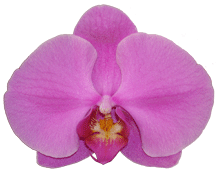Orchid Care Advice for May
 Join Our Newsletter
Join Our Newsletter
Enter your email to receive our free monthly orchid care tips!
Enter Email Here:
Orchid Supplies Corner
To Do Now:
May is the time to begin feeding at summertime levels. We like to increase food during the orchid's most active growth months by 50-100%. We recommend FEED ME! MSU Orchid Fertilizer for all year-round fertilizing.
Many orchids benefit greatly from spending summers outside. Many popular genera such as Cattleya, Cymbidium, Dendrobium and Oncidium really grow better and bloom more reliably when treated to the summer outdoors. One point to consider, if an orchid is classified as "high light" it does not mean the kind of full sun that tomato plants require. "High light" is a relative term and refers to the light requirements of the Orchid Family. Dappled shade is a good bet for many "high light" genera.
We now have some really big pots for those really big orchids in your collection. With widths of 12 and 14 inches and a height of over 11 inches these are serious pots for your largest specimens.
After a long winter inside, fungus gnats can get to be really pesky. Check out our all natural approach to these annoying pests.
Looking Ahead:
Native orchids abound and there are hardy varieties suitable for the garden in many areas. We are eagerly awaiting the bloom on our spiking Bletia Striata which grows in the garden next to the Lily bulbs.
In June we are at the height of active growth for most orchids, today's new leaf or pseudobulb is tomorrow's new bloom spike. Protect new growth and old from bacterial infection with Physan 20.
We have an abundance of Phalaenopsis in bloom right now. Those that are not in bloom were just repotted in our Phalaenopsis Monterey Gold Imperial Orchid Mix. We like to get all of our Phals repotted in the Spring and early Summer as they go out of bloom. We're expecting a busy repotting season for the rest of our Phals shortly!
It is wonderful to see the Catasetum, Cynoches and Mormodes growing huge new green leaves after their leafless dry winter rest. It is amazing to see these orchids wake up like clockwork with new roots and growth each spring.
Looking Back:
April is one of the best months of the year for repotting orchids. If you have a lot of orchids to repot, consider getting orchid mix by THE BOX now available in both our exclusive Imperial Orchid Mixes and our Classic Orchid Mixes.
With Spring comes Orchid Shows and new orchids! Check out our care sheet on How to Care for a New Orchid for some practical care tips.
Spring is when we see new growth and orchids enter their prime growing months. FEEDME! MSU Orchid Fertilizer is ideal for feeding orchids year round.
During the repotting process it is critical to keep everything clean and not spread any disease across the collection. Physan 20 is a good general disinfectant, we use it to sterilize cutting tools between plants. We will rotate between 3 Fiskars clippers allowing 2 to soak while 1 is in use. Be careful if you reuse pots, they need to be sterilized between plants. It is easier to use new pots than it is to try to clean the pot. We will reuse a pot on the same orchid if it does not need a change in pot size but that's about it. Stakes and labels, rhizome clips, etc, can all spread disease if not cleaned or replaced.


